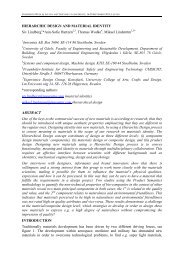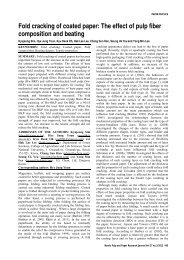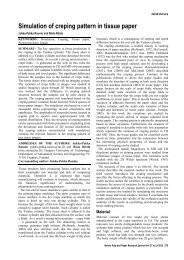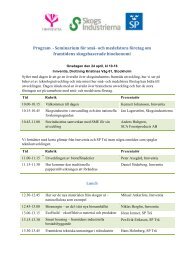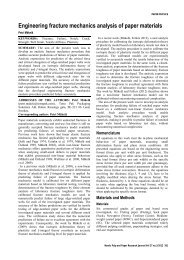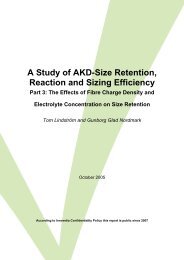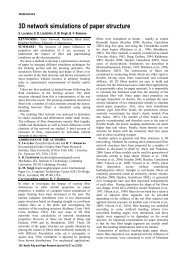Stress-strain curve of paper revisited - Innventia.com
Stress-strain curve of paper revisited - Innventia.com
Stress-strain curve of paper revisited - Innventia.com
You also want an ePaper? Increase the reach of your titles
YUMPU automatically turns print PDFs into web optimized ePapers that Google loves.
PAPER PHYSICS<br />
damage were plotted.<br />
towards the end. It demonstrates again that the hardening<br />
a)<br />
b)<br />
Fig 14. Total amount <strong>of</strong> fractured (solid line) and separated (dashed<br />
line) bonds for networks with different bond strengths: (a) Control,<br />
(b) Weak and (c) Strong bonds.<br />
Although the stronger network has fewer failed bonds, the<br />
failure pattern remains similar. There is a clear localization<br />
zone which indicates the failure path. The fibers which were<br />
pulled out were clearly indicated by the continual chain <strong>of</strong><br />
separated contacts.<br />
Fig 16 shows the <strong>strain</strong> fields in the direction <strong>of</strong> loading. It<br />
was calculated as a continuous field after mapping the<br />
displacement field onto a 2D mesh. The calculated <strong>strain</strong>s<br />
fields agree well with the measured <strong>strain</strong> fields, Fig 11, in<br />
terms <strong>of</strong> size and magnitude <strong>of</strong> variations.<br />
The <strong>strain</strong> field in the Fig 16a was output when the network<br />
with weak bonds reached the maximum stress, that is,<br />
around 0.7% <strong>strain</strong>. Fig 16b shows the <strong>strain</strong> field in the<br />
network with no debonding also at 0.7% <strong>strain</strong>. Apart from<br />
greater <strong>strain</strong> variations in the network with weaker bonds,<br />
both <strong>strain</strong> fields have similar features. The locations <strong>of</strong><br />
maximum <strong>strain</strong>s were the same for both cases. At the same<br />
time, the locations <strong>of</strong> the separated bonds, Fig 15b,<br />
correlated with the areas where the local <strong>strain</strong>s were larger,<br />
Fig 16a. This means that the bond failures are largely<br />
affected by the local <strong>strain</strong>s and not the other way around. In<br />
other words, large local <strong>strain</strong>s are the precursors <strong>of</strong> bond<br />
failures. The local <strong>strain</strong> variations depend, in their turn, on<br />
the initial details <strong>of</strong> the network structure, such as local fiber<br />
orientations, number <strong>of</strong> bonds and density. This is different<br />
from wet networks, where <strong>strain</strong> variations are largely<br />
affected by the stick-slip behavior <strong>of</strong> the bonds.<br />
Effect <strong>of</strong> plasticity<br />
We investigated how plasticity on the fiber level affects the<br />
stress <strong>strain</strong> <strong>curve</strong> and micromechanical processes during<br />
<strong>strain</strong>ing. We <strong>com</strong>pared the simulation with and without<br />
invoking bilinear plasticity for the fibers.<br />
Fig 17 shows that the network with elastic fibers follows a<br />
straight line up until the failure showing some deviation<br />
324 Nordic Pulp and Paper Research Journal Vol 27 no.2/2012<br />
c)<br />
Fig 15. (a) The initial contact positions prior to loading. Total<br />
number <strong>of</strong> contacts at different levels <strong>of</strong> fracture, represented by<br />
the contour legend, where 0 and 1 corresponds to reaching fracture<br />
and separation distances respectively: (b) weak bonds; (c) strong<br />
bonds.<br />
a)<br />
b)<br />
Fig 16. Strain field in the network with (a) weak bonds prior to<br />
failure at a global <strong>strain</strong> <strong>of</strong> 0.7%, (b) no debonding at a global <strong>strain</strong><br />
<strong>of</strong> 0.7%.<br />
behavior <strong>of</strong> the network is mainly controlled by the fibers<br />
and not by the bonds. Interestingly, the strength <strong>of</strong> these two<br />
networks was almost identical.<br />
Assigning a linear elastic material model for fibers resulted<br />
in almost 20% fewer fiber-fiber bonds <strong>com</strong>pletely separated<br />
prior to network rupture <strong>com</strong>pared to the case when a plastic<br />
behavior <strong>of</strong> fibers was assumed, Fig 18.<br />
This can be explained by the fact that a network consisting<br />
<strong>of</strong> elastic fibers sustains sharper <strong>strain</strong> variations as the



